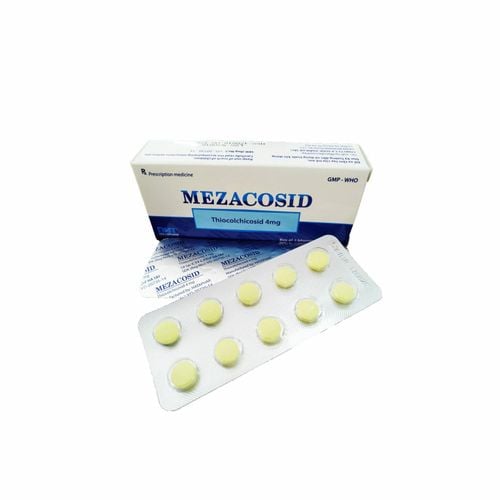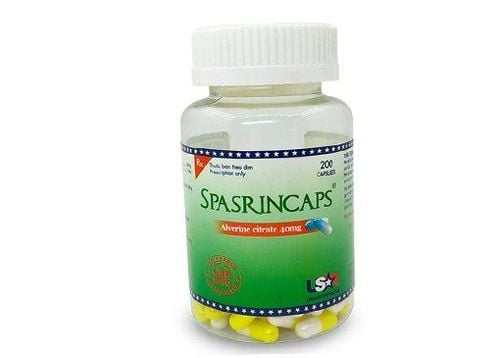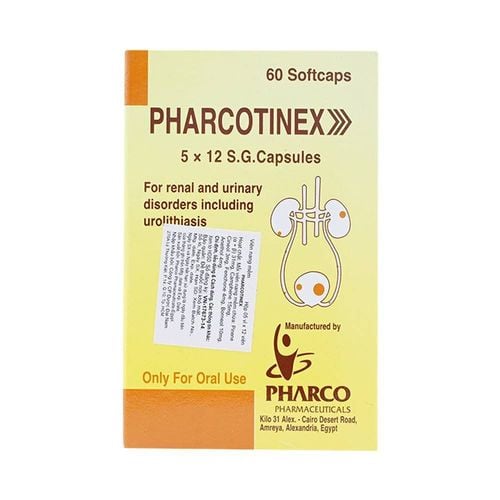This is an automatically translated article.
Hyoscine Butylbromide has antispasmodic effect, supporting pain relief due to spasm very effectively. This active ingredient is found in many different commercial products, including the drug Atithios. So what effect does Atithios drug and in what cases is it indicated?
1. What is Atithios?
What is Atithios? Atithios medicine has the main active ingredient Hyoscin butylbromide 20 mg/ml. Atithios is a product of An Thien Pharmaceutical Joint Stock Company (Vietnam), prepared in the form of an injectable solution and packaged in a box of 5, 10 or 20 ampoules with a volume of 1ml.
2. What are the effects of Atithios?
What does Atithios do? The active ingredient in Atithios is Hyoscine Butylbromide, which is essentially an antispasmodic, so when used, it helps relieve pain caused by muscle spasms.
Atithios has antispasmodic effect on smooth muscle in some organs such as stomach, intestinal tract, biliary tract and urinary tract. Due to its chemical structure as a quaternary ammonium derivative, Hyoscine butylbromide does not enter the central nervous system. Therefore, Atithios does not cause central anticholinergic side effects.
Meanwhile, the peripheral anticholinergic effect of Atithios is due to Hyoscine Butylbromide blocking the superior ganglia on the visceral wall, and combined with the anti-muscarinic effect.
3. Indications and contraindications of Atithios
Atithios is indicated for the treatment of the following conditions:
Acute gastrointestinal, biliary and genitourinary spasms, including biliary colic and renal colic; Assists in performing imaging facilities that are susceptible to spasms such as gastroscopy and radiography. However, the following cases should not use Atithios (contraindications):
Patients with hypersensitivity to Hyoscine butylbromide or any ingredient in Atithios; Patients with certain diseases such as myasthenia gravis, mechanical stenosis in the gastrointestinal tract, paralysis or intestinal obstruction, untreated narrow-angle glaucoma, prostate enlargement accompanied by urinary retention or tachycardia; Atithios intramuscular injection is contraindicated in patients taking anticoagulants, due to the risk of hematoma formation in the muscle. In these cases, it should be replaced by subcutaneous or intravenous injection.
4. Dosage, how to use Atithios
Atithios 20mg/ml can be used by slow intravenous injection, intramuscular injection or subcutaneous injection with the recommended dose as follows:
Note that patients should not use Atithios daily or for a long time without undetermined cause of painful muscle spasms; Adults and children over 12 years: 1-2 ampoules of Atithios (equivalent to 20-40mg Hyoscine butylbromide) several times daily. However, the maximum daily dose should not exceed 5 ampoules of Atithios 20mg/ml (100mg); Infants and children: Atithios should only be used for severe pain caused by severe muscle spasms with a dose of 0.3-0.6mg/kg body weight/day divided into several injections. The maximum dose for this subject should not exceed 1.5mg/kg body weight. The above dosage of Atithios is for reference only. The specific dosage will be prescribed by the doctor, depending on the patient's condition and progress.
Hyoscine Butylbromide overdose and management:
In case of overdose, the patient may experience symptoms due to anticholinergic effects; Treatment: In case of necessity, the use of parasympathomimetic drugs can be considered; Acute glaucoma should be diagnosed by an ophthalmologist; Cardiovascular complications from Atithios overdose should be managed according to the principles of conventional treatment; In case of respiratory paralysis, intubation and mechanical ventilation may be required; Patients with urinary retention may require urinary catheterization. At the same time, cases of Atithios overdose should be intervened, supporting symptoms (if any).
5. Side effects of Atithios
Side effects of Atithios drug that may occur during use are as follows:
Anaphylaxis due to Atithios medicine can lead to death or milder symptoms of anaphylaxis such as difficulty breathing, raised eyebrows. urticaria, rash, pruritus and certain other hypersensitivity conditions; Increased heart rate ; Dry mouth; Sweating disorders; urinary retention; Eye muscle dysregulation, dilated pupils or glaucoma; Hypotension; Dizziness or flushing.
6. Atithios drug interactions
Anticholinergic effects of some other classes of drugs such as tricyclic antidepressants, antihistamines, antipsychotics, Quinidine, Amantadine, Disopyramide and some other anticholinergics (eg Tiotropium, Ipratropium, compounds) like Atropin ) can be enhanced when co-administered with Atithios .
Concomitant treatment of Atithios with Dopamine antagonists (such as Metoclopramide) may reduce the therapeutic effect of both drugs on the gastrointestinal tract.
The bradycardia effect of beta-adrenoceptor stimulants may be enhanced by Atithios.
7. Notes when using Atithios
During the use of Atithios, patients should note:
Patients with severe abdominal pain, the cause of which is not clear, causes persistent pain or increasing pain, or pain accompanied by other symptoms such as: fever, nausea, vomiting, changes in bowel movements, low blood pressure, fainting or bloody stools... it is necessary to use appropriate diagnostic measures to find the cause before using Atithios. Because of the potential risk of anticholinergic complications, Atithios should be used with caution in patients with narrow-angle glaucoma, at risk of intestinal or urinary tract obstruction, or with a predisposition to tachyarrhythmias. Glaucoma may develop with the use of anticholinergics such as Atithios in patients with previously undiagnosed and untreated narrow-angle glaucoma. Therefore, patients need to see an ophthalmologist immediately to prevent eye pain, redness and loss of vision after injection of Atithios. Following injection of Atithios, cases of hypersensitivity including anaphylaxis have been reported. As with all medications, physicians should closely monitor patients when administering Atithios parenteral. With caution and regular monitoring of patients with a history of cardiovascular disease being treated with Atithios. No studies on the effects of Hyoscine Butylbromide on the ability to drive and use machines have been performed. However, doctors should warn patients about the possibility of undesirable effects such as disturbances in eye accommodation or dizziness during treatment with Atithios. Therefore, patients taking Atithios should be careful when driving or operating machinery, in case of eye disorder or dizziness, they must avoid jobs that can be dangerous. There are limited data on the use of Hyoscine butylbromide in pregnant women. However, animal studies have not indicated a direct or indirect harmful effect of Atithios on reproductive function. There is insufficient information on the excretion into breast milk of Hyoscine butylbromide and its metabolites. To prevent adverse effects, it is best for patients to avoid Atithios during pregnancy and lactation. Atithios medicine has the main active ingredient Hyoscin butylbromide with the content of 20 mg/ml. Atithios is indicated for the treatment of pain, muscle spasms in many cases, and at the same time supporting the implementation of imaging facilities that are susceptible to spasms such as gastroscopy and X-ray. optical. Patients need to strictly follow the instructions of the doctor, medical staff to achieve the highest efficiency.
Follow Vinmec International General Hospital website to get more health, nutrition and beauty information to protect the health of yourself and your loved ones in your family.
Please dial HOTLINE for more information or register for an appointment HERE. Download MyVinmec app to make appointments faster and to manage your bookings easily.













